Holly Thompson's Blog, page 7
April 7, 2020
30 Hope Poems: 7. Eastern Box Turtle
Day 7 of my National Poetry Month project of 30 Hope Poems focused on native plant and animal species that are protected under the Massachusetts Endangered Species Act.
Hopes for an Eastern Box Turtle Eastern Box Turtle (Mass Audubon)
Eastern Box Turtle (Mass Audubon)
forest floors inupland woodlandsmuddy shallows ofopen wetlandskindly soulsto help with travellifting overasphalt and gravela shallow holeto lay a clutchsoil and grass tocover eggs up
worms to eatand caterpillarsberries, mushroomseven flowersferns and mossfor making domesthe right to stayin a natural homeponds for lazingon summer dayssoil for burrowingas autumn fades
©2020 Holly Thompson All rights reserved
The Eastern Box Turtle (Terrapene carolina) is listed under the Massachusetts Endangered Species act as a species of Special Concern. See Eastern Box Turtle in Mass Wildlife’s Natural Heritage and Endangered Species Program.
Write!What species are Endangered, Threatened or of Special Concern where you live? What information can you find about them? What hopes can you imagine for them? Write your own hope poem and post in the comments to share.
Holly Thompson (www.hatbooks.com) is an author who lives in Japan but grew up in Massachusetts where she is now sheltering during the coronavirus pandemic, getting outside to walk and observe wildlife whenever she can.

Hopes for an Eastern Box Turtle
 Eastern Box Turtle (Mass Audubon)
Eastern Box Turtle (Mass Audubon)forest floors inupland woodlandsmuddy shallows ofopen wetlandskindly soulsto help with travellifting overasphalt and gravela shallow holeto lay a clutchsoil and grass tocover eggs up
worms to eatand caterpillarsberries, mushroomseven flowersferns and mossfor making domesthe right to stayin a natural homeponds for lazingon summer dayssoil for burrowingas autumn fades
©2020 Holly Thompson All rights reserved
The Eastern Box Turtle (Terrapene carolina) is listed under the Massachusetts Endangered Species act as a species of Special Concern. See Eastern Box Turtle in Mass Wildlife’s Natural Heritage and Endangered Species Program.
Write!What species are Endangered, Threatened or of Special Concern where you live? What information can you find about them? What hopes can you imagine for them? Write your own hope poem and post in the comments to share.
Holly Thompson (www.hatbooks.com) is an author who lives in Japan but grew up in Massachusetts where she is now sheltering during the coronavirus pandemic, getting outside to walk and observe wildlife whenever she can.

Published on April 07, 2020 05:00
April 6, 2020
30 Hope Poems: 6. Short-eared Owl
Day 6 of my National Poetry Month project of 30 Hope Poems focused on native plant and animal species that are protected under the Massachusetts Endangered Species Act.
Hopes for a Short-eared Owl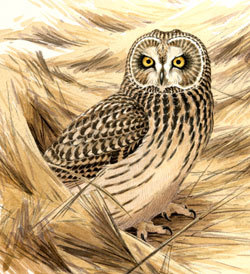 Short-eared Owl (Mass Audubon)
Short-eared Owl (Mass Audubon)
a mate that loves a wing-flap showfrom soaring heights to ground belowa quiet place to build a nest withsun-dried grass--a sand plain's best
plus heathlands, scrub, and wild rosegrassy lands with tons of volesearly mornings, evening twilightideal hours for hover-and-pounce flights
©2020 Holly Thompson All rights reserved
The Short-eared Owl (Asio flammeus) is listed under the Massachusetts Endangered Species act as Endangered. See Short-eared Owl in Mass Wildlife’s Natural Heritage and Endangered Species Program.
Write!What species are Endangered, Threatened or of Special Concern where you live? What information can you find about them? What hopes can you imagine for them? Write your own hope poem and post in the comments to share.
Holly Thompson (www.hatbooks.com) is an author who lives in Japan but grew up in Massachusetts where she is now sheltering during the coronavirus pandemic, getting outside to walk and observe wildlife whenever she can.

Hopes for a Short-eared Owl
 Short-eared Owl (Mass Audubon)
Short-eared Owl (Mass Audubon)a mate that loves a wing-flap showfrom soaring heights to ground belowa quiet place to build a nest withsun-dried grass--a sand plain's best
plus heathlands, scrub, and wild rosegrassy lands with tons of volesearly mornings, evening twilightideal hours for hover-and-pounce flights
©2020 Holly Thompson All rights reserved
The Short-eared Owl (Asio flammeus) is listed under the Massachusetts Endangered Species act as Endangered. See Short-eared Owl in Mass Wildlife’s Natural Heritage and Endangered Species Program.
Write!What species are Endangered, Threatened or of Special Concern where you live? What information can you find about them? What hopes can you imagine for them? Write your own hope poem and post in the comments to share.
Holly Thompson (www.hatbooks.com) is an author who lives in Japan but grew up in Massachusetts where she is now sheltering during the coronavirus pandemic, getting outside to walk and observe wildlife whenever she can.

Published on April 06, 2020 05:00
April 5, 2020
30 Hope Poems: 5. Foxtail Clubmoss
Day 5 of my National Poetry Month project of 30 Hope Poems focused on native plant and animal species that are protected under the Massachusetts Endangered Species Act.
Hopes for Foxtail Clubmoss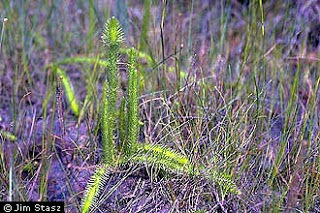 Foxtail Clubmoss (USDA)
Foxtail Clubmoss (USDA)
bogs of peat or nice damp sandto creep along with arching stems
and raise up shoots with glossy clubs—strobili packed with tons of spores
to toss as powder into wind andslowly grow and creep more stems
beneath the paths of powerlinesalongside shores of peaceful ponds
©2020 Holly Thompson All rights reserved
Foxtail Clubmoss (Lycopodiella alopecuroides) is listed under the Massachusetts Endangered Species act as Endangered. See Foxtail Clubmoss in the Natural Heritage and Endangered Species Program.
Write!What species are Endangered, Threatened or of Special Concern where you live? What information can you find about them? What hopes can you imagine for them? Write your own hope poem and post in the comments to share.
Holly Thompson (www.hatbooks.com) is an author who lives in Japan but grew up in Massachusetts where she is now sheltering during the coronavirus pandemic, getting outside to walk and observe wildlife whenever she can.
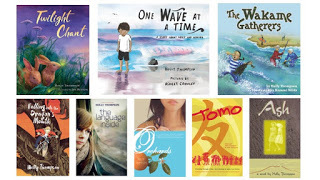
Hopes for Foxtail Clubmoss
 Foxtail Clubmoss (USDA)
Foxtail Clubmoss (USDA)bogs of peat or nice damp sandto creep along with arching stems
and raise up shoots with glossy clubs—strobili packed with tons of spores
to toss as powder into wind andslowly grow and creep more stems
beneath the paths of powerlinesalongside shores of peaceful ponds
©2020 Holly Thompson All rights reserved
Foxtail Clubmoss (Lycopodiella alopecuroides) is listed under the Massachusetts Endangered Species act as Endangered. See Foxtail Clubmoss in the Natural Heritage and Endangered Species Program.
Write!What species are Endangered, Threatened or of Special Concern where you live? What information can you find about them? What hopes can you imagine for them? Write your own hope poem and post in the comments to share.
Holly Thompson (www.hatbooks.com) is an author who lives in Japan but grew up in Massachusetts where she is now sheltering during the coronavirus pandemic, getting outside to walk and observe wildlife whenever she can.

Published on April 05, 2020 05:00
April 4, 2020
30 Hope Poems: 4. Eastern Ratsnake
Day 4 of my National Poetry Month project of 30 Hope Poems focused on native plant and animal species that are protected under the Massachusetts Endangered Species Act.
Hopes for an Eastern Ratsnake Eastern Ratsnake (Mass.gov Learn about Eastern Ratsnakes)
Eastern Ratsnake (Mass.gov Learn about Eastern Ratsnakes)
©2020 Holly Thompson All rights reserved
The Eastern Ratsnake (Pantherophis alleghaniensis) is listed under the Massachusetts Endangered Species act as Endangered. See Eastern Ratsnake in the Natural Heritage and Endangered Species Program.
Write!What species are Endangered, Threatened or of Special Concern where you live? What information can you find about them? What hopes can you imagine for them? Write your own hope poem and post in the comments to share.
Holly Thompson (www.hatbooks.com) is an author who lives in Japan but grew up in Massachusetts where she is now sheltering during the coronavirus pandemic, getting outside to walk and observe wildlife whenever she can.
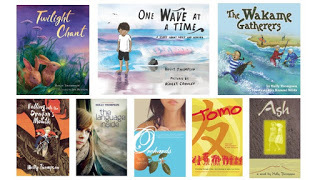
Hopes for an Eastern Ratsnake
 Eastern Ratsnake (Mass.gov Learn about Eastern Ratsnakes)
Eastern Ratsnake (Mass.gov Learn about Eastern Ratsnakes)for winter monthsa hidden hibernaculum—a den to return to year after year in asouthfacing outcropsafe from hawkswith sun-baked rocksfor spring and autumnand summer daysin thickets and fieldswith trees to climband empty barnswith rats and voleslizards and micehatchlings and eggsgalore to swallowtill days turn cooland it’s time againto chill in the secrethibernaculum
©2020 Holly Thompson All rights reserved
The Eastern Ratsnake (Pantherophis alleghaniensis) is listed under the Massachusetts Endangered Species act as Endangered. See Eastern Ratsnake in the Natural Heritage and Endangered Species Program.
Write!What species are Endangered, Threatened or of Special Concern where you live? What information can you find about them? What hopes can you imagine for them? Write your own hope poem and post in the comments to share.
Holly Thompson (www.hatbooks.com) is an author who lives in Japan but grew up in Massachusetts where she is now sheltering during the coronavirus pandemic, getting outside to walk and observe wildlife whenever she can.

Published on April 04, 2020 05:00
April 3, 2020
30 Hope Poems: 3. Piping Plover
Day 3 of my National Poetry Month project of 30 Hope Poems focused on native plant and animal species that are protected under the Massachusetts Endangered Species Act.
Hopes for a Piping Plover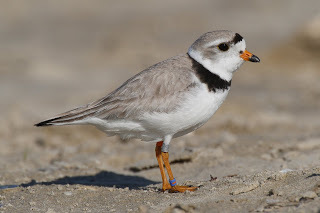 Piping Plover (Wikipedia)
Piping Plover (Wikipedia)
between high tide lineand rolling dunessome undisturbed sandto scrape a hollowplace some pebblesbits of shells and layfour eggs in peace
no intrudersno dogsno humans
as the young hatchand patter over sandlearn to pick at seaweedand scurry and pauseall along the waterlinefor Atlantic-chilled mealsof mollusks and worms
©2020 Holly Thompson All rights reserved
Piping Plover (Charadrius melodus) is listed under the Massachusetts Endangered Species act as Threatened. See Piping Plover in the Natural Heritage and Endangered Species Program.
Write!What species are Endangered, Threatened or of Special Concern where you live? What information can you find about them? What hopes can you imagine for them? Write your own hope poem and post in the comments to share.
Holly Thompson (www.hatbooks.com) is an author who lives in Japan but grew up in Massachusetts where she is now sheltering during the coronavirus epidemic, getting outside to walk and observe wildlife whenever she can.

Hopes for a Piping Plover
 Piping Plover (Wikipedia)
Piping Plover (Wikipedia)between high tide lineand rolling dunessome undisturbed sandto scrape a hollowplace some pebblesbits of shells and layfour eggs in peace
no intrudersno dogsno humans
as the young hatchand patter over sandlearn to pick at seaweedand scurry and pauseall along the waterlinefor Atlantic-chilled mealsof mollusks and worms
©2020 Holly Thompson All rights reserved
Piping Plover (Charadrius melodus) is listed under the Massachusetts Endangered Species act as Threatened. See Piping Plover in the Natural Heritage and Endangered Species Program.
Write!What species are Endangered, Threatened or of Special Concern where you live? What information can you find about them? What hopes can you imagine for them? Write your own hope poem and post in the comments to share.
Holly Thompson (www.hatbooks.com) is an author who lives in Japan but grew up in Massachusetts where she is now sheltering during the coronavirus epidemic, getting outside to walk and observe wildlife whenever she can.

Published on April 03, 2020 05:00
April 2, 2020
30 Hope Poems: 2. Eastern Spadefoot
Day 2 of my National Poetry Month project of 30 Hope Poems focused on native plant and animal species that are protected under the Massachusetts Endangered Species Act.
Hopes for an Eastern Spadefoot
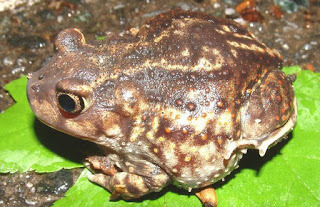 Eastern Spadefoot (Wikipedia)
Eastern Spadefoot (Wikipedia)
The Eastern Spadefoot (Scaphiopus holbrookii) is a toad that is listed under the Massachusetts Endangered Species act as Threatened. See Eastern Spadefoot in the Natural Heritage and Endangered Species Program.
WRITE!What species are Endangered, Threatened or of Special Concern where you live? What information can you find about them? What hopes can you imagine for them? Write your own hope poem and post in the comments to share.
Holly Thompson (www.hatbooks.com) is an author who lives in Japan but grew up in Massachusetts where she is now sheltering during the coronavirus pandemic, getting outside to walk and observe wildlife whenever she can.

Hopes for an Eastern Spadefoot
 Eastern Spadefoot (Wikipedia)
Eastern Spadefoot (Wikipedia)safe paths
for crossing
to vernal pools
for eggs to hatch
plankton galore
for tadpoles to nibble
and strong spade legs
to hop overland
warm nights©2020 Holly Thompson All rights reserved
busy with insects
soft soil
to dig a deep home
leaves for lining
all the way down
a comfy burrow
to spiral into
and hibernate
for days
and weeks
on end
The Eastern Spadefoot (Scaphiopus holbrookii) is a toad that is listed under the Massachusetts Endangered Species act as Threatened. See Eastern Spadefoot in the Natural Heritage and Endangered Species Program.
WRITE!What species are Endangered, Threatened or of Special Concern where you live? What information can you find about them? What hopes can you imagine for them? Write your own hope poem and post in the comments to share.
Holly Thompson (www.hatbooks.com) is an author who lives in Japan but grew up in Massachusetts where she is now sheltering during the coronavirus pandemic, getting outside to walk and observe wildlife whenever she can.

Published on April 02, 2020 05:00
March 31, 2020
30 Hope Poems: 1. Yellow Oak
Day 1 of my National Poetry Month project of 30 Hope Poems focused on native plant and animal species that are protected under the Massachusetts Endangered Species Act.
Yellow Oak (Quercus muehlenbergii) is listed under the Massachusetts Endangered Species act as Threatened. See Yellow Oak in the Natural Heritage and Endangered Species Program (mass.gov.nhesp).
Holly Thompson (www.hatbooks.com) is an author who lives in Japan but grew up in Massachusetts where she is sheltering during the coronavirus epidemic, getting outside to walk and observe wildlife whenever she can.
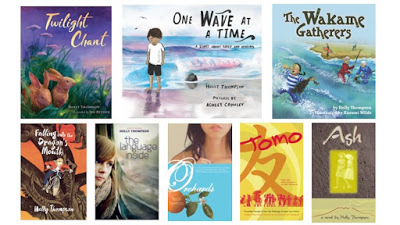
Hopes for a Yellow OakYellow Oak (Quercus muehlenbergii) photo: Wikipedia, Vojtěch Zavadil
fine soil below
for roots to spread
warm sun above
for a crown to green
catkins to bloom
into acorns that drop
to be gathered and traveled
by chipmunks and squirrels
©2020 Holly Thompson All rights reservedand company—
white, red, black
oaks of all varieties
in stands nearby
just enough apart
to associate
in close proximity
together in broadleaf
community
Yellow Oak (Quercus muehlenbergii) is listed under the Massachusetts Endangered Species act as Threatened. See Yellow Oak in the Natural Heritage and Endangered Species Program (mass.gov.nhesp).
Holly Thompson (www.hatbooks.com) is an author who lives in Japan but grew up in Massachusetts where she is sheltering during the coronavirus epidemic, getting outside to walk and observe wildlife whenever she can.

Published on March 31, 2020 21:28
March 27, 2020
Teaching Cesar Chavez in Japan
For #PoetryFriday, during National Farmworker Awareness Week as I shelter in Massachusetts, a celebration of Cesar Chavez in advance of Cesar Chavez Day on March 31.

For a bit of history into Japanese and Mexican American farm workers in the U.S., see this Densho piece on PRI, which also touches on efforts by sansei citizens to convince their elders to support the United Farm Workers movement and boycotts.
In these coronavirus times as I self isolate, I am deeply grateful to all farmworkers--so many of them working and living in unsafe conditions and at high risk themselves--for keeping us fed .
Visit these organizations:
United Farm Workers
Agricultural Justice Project
Farmworker Justice
And see all the other #Poetry Friday posts. Here's the schedule of who's hosting when.

Teaching Cesar Chavez in Japan© 2020 Holly Thompson All rights reserved.
my students in Japantend to believe they cannotparticipate in protests
my students thinkthey cannot riskbeing seen at a march
even to support actionsto fight climate changeon an imperiled island nation
they’ll share ideas of whateveryone should doto sustain this earth
to protect farm villagesfishing communitieslaborers from overseas
but by everyonethey tend to meannot me, individually
so I open the door, invite you in, Cesar,let your words and protestswash over us all, then ask again
what will you, us, weeach one of us heredo to make a difference
For a bit of history into Japanese and Mexican American farm workers in the U.S., see this Densho piece on PRI, which also touches on efforts by sansei citizens to convince their elders to support the United Farm Workers movement and boycotts.
In these coronavirus times as I self isolate, I am deeply grateful to all farmworkers--so many of them working and living in unsafe conditions and at high risk themselves--for keeping us fed .
Visit these organizations:
United Farm Workers
Agricultural Justice Project
Farmworker Justice
And see all the other #Poetry Friday posts. Here's the schedule of who's hosting when.
Published on March 27, 2020 10:33
March 20, 2020
YCU Footprints Literary Magazine
Since 2003, I've taught English-language creative writing courses at Yokohama City University in both poetry and fiction writing, in addition to various other courses. In recent years, my semester-long creative writing courses have been offered in fiction only--but don't worry--I sneak poetry into all my other courses : )
In previous years, I compiled an annual anthology of student creative writing work that was distributed to students and made available in the university bookstore. When my funding disappeared, I shifted to a photocopied collection handed out to students on the last day of class. Now we move Footprints online.
A bit of context. Courses in Japanese universities typically meet for one ninety-minute class per week, for fifteen weeks. Most students in my fiction writing courses have limited writing experience in English and most have never written a short story. Yet my creative writing semester courses include reading short stories, learning fiction craft, drafting multiple story starts, developing one story to completion, revising, workshopping, editing and polishing. With limited contact hours, these courses are intense rigorous sprints. And my students--Japanese nationals, returnees, exchange students--always deliver, surprising both me and themselves as they evolve into storytellers and English-language writers, regardless of their level of English.
Here, with permission of Yokohama City University and the student writers, I present Footprints 2019 and Footprints 2018 short story collections from my Elements of Fiction creative writing courses, with teasers below for each story.
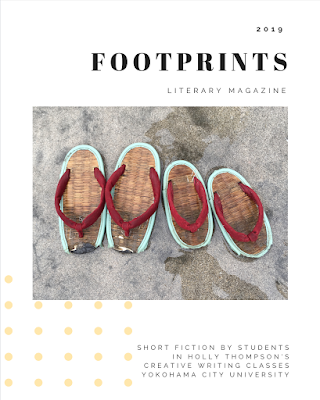 Footprints 2019
Footprints 2019
Footprints 2019
In Elegy of a Ghost by Hitomi Igarashi, a ghost woman observes her husband's daily routine remaining the same . . . until it doesn't.
In Undamaged by Kota Shiraishi, cool-headed Reiji tries to maintain distance from friends, but things get complicated.
In Spirited Away Birthday Girl by Maho Yamashita, a lost child incident in a grocery story escalates into a mystery.
In 8.761:27:30 by Rita Gratz, an elderly man sees dates that others can't and tries to warn a nurse who doesn't believe him.
In Heart Mark by Ayane Yaguchi, a young girl takes actionat the precipice of a family separation.
In Struck by Lightning by Azusa Tamura, Miki crushes on a substitute cram school teacher.
In Deep Encounters by Georgia Velluti, a mystery unfolds as a result of a drunken late night fall into a Venice canal.
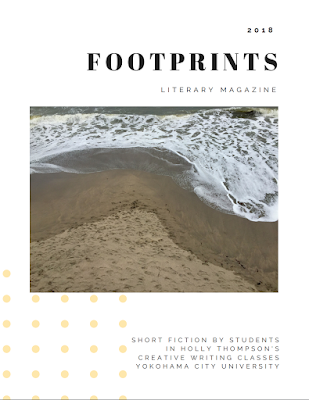 Footprints 2018
Footprints 2018
Footprints 2018
In Country Life with a Town Girl by Natsuki Rokudo, a young boy contends with a city-wise girl sent to live with his family in the country.
In The Hour Before the World Ends by Shusei Oyamada, a meandering young man at the end of the world encounters a drowning dog, a woman in a remote dagashi store, and a strange small child.
In A Message Through the Melody by Ena Shionyu, a school harpist discovers her own composition score is missing, then returned but edited.
In The Worlds Collide by Ralph Ace Sta. Maria, a roving historical fantasy builds around Saturio, a deserter from the colonial Spanish army.
In Long Hand, Short Hand by S. Sato, Lucas tries to process his own grief while raising his motherless daughter.
In The Florist by Minami Isaka, a dual narrative shifts between the quiet lives of an NHK fee collector and a florist.
In There by Yuina Mashima, Anna, mother of Jun, tries valiantly to defeat her fears about her disappeared husband.
In Secret by Haruka Urushiyama, Kazuya struggles to solve the mystery of a murdered former classmate.
In Late Boy by Maki Kawasaki, a soccer player late for school, assists an elderly woman and risks being dropped from the team.
In The Mirror by Koki Ebata, Sana enters a parallel world in which her boyfriend hasn't really broken up with her, which seems great at first.
In The Room by Ren Itakura, karate pro Eddy Yamada is mugged then finds himself a captive brought to another planet to fight in a colosseum.
In Winter Sleep by Kanako Sugawara, Ryoko wakes disoriented and discovers she is many years in her future.
Enjoy!
I firmly believe that creative writing courses should be included in all higher education EFL programs. Everyone, regardless of English-language experience can tell compelling stories in English. And fiction, poetry, creative nonfiction and other forms of creative writing are fundamental and essential modes of human connection and communications in the twenty-first century. My hope is that my Yokohama City University writing students will continue to build on their creativity and communication skills as they journey through university and onward into the world, wherever their bold aims may lead.
In previous years, I compiled an annual anthology of student creative writing work that was distributed to students and made available in the university bookstore. When my funding disappeared, I shifted to a photocopied collection handed out to students on the last day of class. Now we move Footprints online.
A bit of context. Courses in Japanese universities typically meet for one ninety-minute class per week, for fifteen weeks. Most students in my fiction writing courses have limited writing experience in English and most have never written a short story. Yet my creative writing semester courses include reading short stories, learning fiction craft, drafting multiple story starts, developing one story to completion, revising, workshopping, editing and polishing. With limited contact hours, these courses are intense rigorous sprints. And my students--Japanese nationals, returnees, exchange students--always deliver, surprising both me and themselves as they evolve into storytellers and English-language writers, regardless of their level of English.
Here, with permission of Yokohama City University and the student writers, I present Footprints 2019 and Footprints 2018 short story collections from my Elements of Fiction creative writing courses, with teasers below for each story.
 Footprints 2019
Footprints 2019Footprints 2019
In Elegy of a Ghost by Hitomi Igarashi, a ghost woman observes her husband's daily routine remaining the same . . . until it doesn't.
In Undamaged by Kota Shiraishi, cool-headed Reiji tries to maintain distance from friends, but things get complicated.
In Spirited Away Birthday Girl by Maho Yamashita, a lost child incident in a grocery story escalates into a mystery.
In 8.761:27:30 by Rita Gratz, an elderly man sees dates that others can't and tries to warn a nurse who doesn't believe him.
In Heart Mark by Ayane Yaguchi, a young girl takes actionat the precipice of a family separation.
In Struck by Lightning by Azusa Tamura, Miki crushes on a substitute cram school teacher.
In Deep Encounters by Georgia Velluti, a mystery unfolds as a result of a drunken late night fall into a Venice canal.
 Footprints 2018
Footprints 2018Footprints 2018
In Country Life with a Town Girl by Natsuki Rokudo, a young boy contends with a city-wise girl sent to live with his family in the country.
In The Hour Before the World Ends by Shusei Oyamada, a meandering young man at the end of the world encounters a drowning dog, a woman in a remote dagashi store, and a strange small child.
In A Message Through the Melody by Ena Shionyu, a school harpist discovers her own composition score is missing, then returned but edited.
In The Worlds Collide by Ralph Ace Sta. Maria, a roving historical fantasy builds around Saturio, a deserter from the colonial Spanish army.
In Long Hand, Short Hand by S. Sato, Lucas tries to process his own grief while raising his motherless daughter.
In The Florist by Minami Isaka, a dual narrative shifts between the quiet lives of an NHK fee collector and a florist.
In There by Yuina Mashima, Anna, mother of Jun, tries valiantly to defeat her fears about her disappeared husband.
In Secret by Haruka Urushiyama, Kazuya struggles to solve the mystery of a murdered former classmate.
In Late Boy by Maki Kawasaki, a soccer player late for school, assists an elderly woman and risks being dropped from the team.
In The Mirror by Koki Ebata, Sana enters a parallel world in which her boyfriend hasn't really broken up with her, which seems great at first.
In The Room by Ren Itakura, karate pro Eddy Yamada is mugged then finds himself a captive brought to another planet to fight in a colosseum.
In Winter Sleep by Kanako Sugawara, Ryoko wakes disoriented and discovers she is many years in her future.
Enjoy!
I firmly believe that creative writing courses should be included in all higher education EFL programs. Everyone, regardless of English-language experience can tell compelling stories in English. And fiction, poetry, creative nonfiction and other forms of creative writing are fundamental and essential modes of human connection and communications in the twenty-first century. My hope is that my Yokohama City University writing students will continue to build on their creativity and communication skills as they journey through university and onward into the world, wherever their bold aims may lead.
Published on March 20, 2020 10:04
March 12, 2020
Tōhoku Tribute, 9 Years After
March 11, 2020 was the ninth anniversary of the Great East Japan earthquake and tsunami.
This past October, not long after typhoon Hagibis devastated much of Honshu with floods that caused nearly 100 deaths in Tōhoku, I headed north on a trip that had been planned before the typhoon. I bumped up my departure for some flood clean-up work--so many towns in Tohoku needed helping hands.
First stop was the town of Osato in Miyagi Prefecture, where my husband and I had signed up for a day of volunteer flood clean-up. We showed up with our shovels and gear, and the more than 100 volunteers--mostly from nearby towns, but a few like us from distant prefectures--were divided into groups and bussed to a farm district that had been completely inundated--a river had crested the levee. Rice straw and mud was everywhere, along with personal belongings, farm tools, and furniture. Garden harvest vegetables and fruits lay rotting, and sodden rice straw had to be carted away and dumped back into the paddies of the ruined crop. We shoveled muck, pitchforked, lugged items, salvaged little, and made enormous trash heaps.

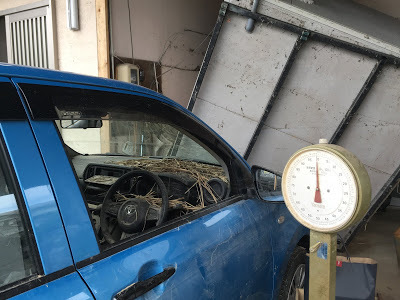
The farm community was grateful for all the help, and though volunteers had brought their own bentō lunches, the family also gave back, serving everyone hearty bowls of soup.

After a day of volunteer work, we drove further north to Ishinomaki, the city where I'd volunteered in the spring and fall of 2011 after the earthquake and tsunami. We found our way to Genki no Yū to soak sore muscles in hot spring waters.
The following day, my main mission was to visit Teiichi Satō and his seed shop in Rikuzentakata, Iwate. Rikuzentakata was one of the hardest hit towns in 2011, slammed by a 13-meter wave that swept away its iconic shoreline pines, most structures, and so many of its inhabitants. Ultimately records revealed that over 1800 people had died or were missing and presumed dead. The town has been rebuilding on raised land.
On a previous visit to Rikuzentakata, I had picked up a copy of Teichi Satō's memoir The Seed of Hope in the Heart--written in English as a means of coping amid overwhelming grief after the tsunami--but I hadn't met him then. I showed up at his seed shop unannounced, and he graciously signed the copy I'd brought and others we purchased. I was so moved to meet him at last, visit his seed shop that he'd rebuilt with such gumption and love after the tsunami, to sit and chat, and hear his voice.
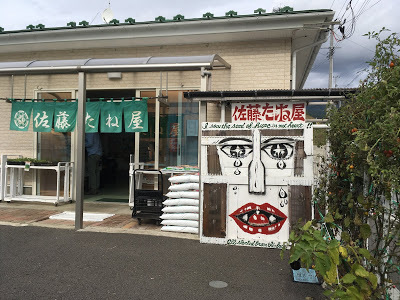 佐藤たね屋ーSatō Seed Shop
佐藤たね屋ーSatō Seed Shop
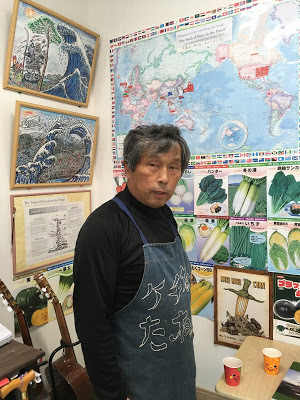 Teiichi Satō in his seed shop
Teiichi Satō in his seed shop

From the seed shop, we continued on to the Gōishi Kaigan for some coastal walks.


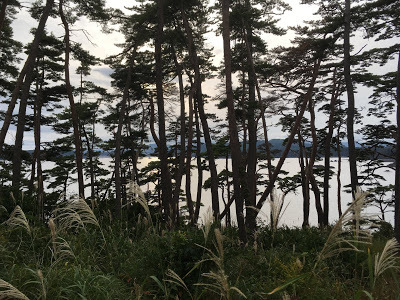
The next morning we met with Takashi Narumiya, one of the four staff members of the NPO Sokoage, which the Tomo Anthology, that I compiled and edited, was able to support in 2019 with proceeds from sales of the book. In the Kesennuma Pier 7 Square Ship co-working space, Narumiya-san filled me in on Sokoage activities. See my recent post about Sokoage and all the great things they are doing in and around Kesennuma.
 Sokoage's Takashi Narumiya
Sokoage's Takashi Narumiya
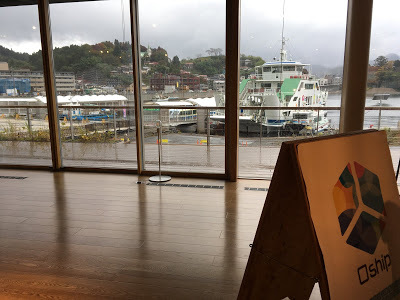 View from Rikuzentakata's Pier 7 on the waterfrontThe following day the sun came out and Minamisanriku was stunning.
View from Rikuzentakata's Pier 7 on the waterfrontThe following day the sun came out and Minamisanriku was stunning.
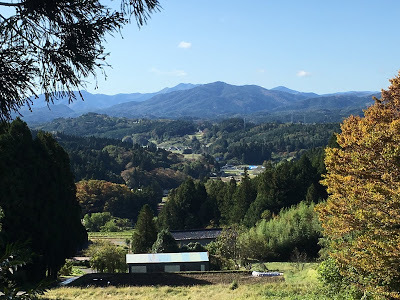
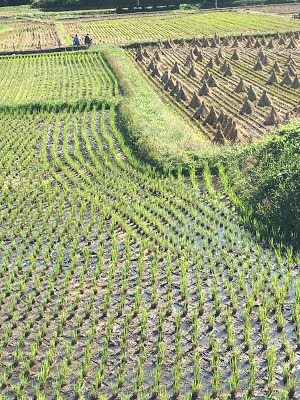
As we headed south, we stopped in Onagawa to see their train station designed by architect Shigeru Ban that also houses the hot spring Yū-poppo, and visit the Seapal Pier shopping area that stretches down to the harbor. We picked up some local crafts, chatted with shop owners, and ate locally caught saury for lunch.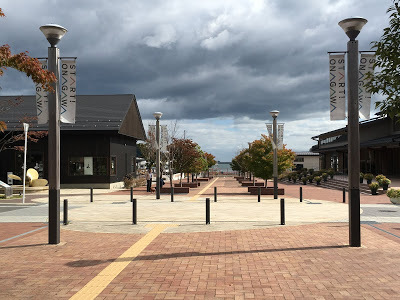 Seapal Pier Shopping Area
Seapal Pier Shopping Area
 Onagawa Station and Yūpoppo Each of the hard hit towns on the Tohoku coast is navigating its own route through recovery. Attitudes and approaches to rebuilding vary--there are so many ways to go forward.
Onagawa Station and Yūpoppo Each of the hard hit towns on the Tohoku coast is navigating its own route through recovery. Attitudes and approaches to rebuilding vary--there are so many ways to go forward.
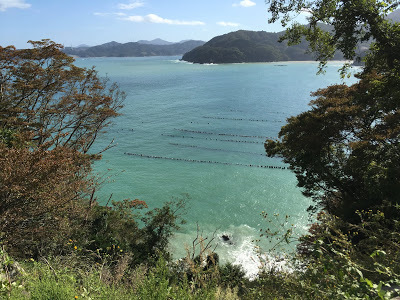
Please pause and take a moment to remember 3/11 by listening to Teiichi Satō play Chopin's Nocturne in E Flat Major (Op. 9 No. 2), as he notes in his Facebook post, in memory of those who lost their lives in the tsunami, in thanks to all those who've supported Rikuzentakata, in hopes that the coronavirus will settle down, and as a wish for all to plant the seeds of happiness in their hearts.
May we all take time to plant those seeds of hope around us.
This past October, not long after typhoon Hagibis devastated much of Honshu with floods that caused nearly 100 deaths in Tōhoku, I headed north on a trip that had been planned before the typhoon. I bumped up my departure for some flood clean-up work--so many towns in Tohoku needed helping hands.
First stop was the town of Osato in Miyagi Prefecture, where my husband and I had signed up for a day of volunteer flood clean-up. We showed up with our shovels and gear, and the more than 100 volunteers--mostly from nearby towns, but a few like us from distant prefectures--were divided into groups and bussed to a farm district that had been completely inundated--a river had crested the levee. Rice straw and mud was everywhere, along with personal belongings, farm tools, and furniture. Garden harvest vegetables and fruits lay rotting, and sodden rice straw had to be carted away and dumped back into the paddies of the ruined crop. We shoveled muck, pitchforked, lugged items, salvaged little, and made enormous trash heaps.


The farm community was grateful for all the help, and though volunteers had brought their own bentō lunches, the family also gave back, serving everyone hearty bowls of soup.

After a day of volunteer work, we drove further north to Ishinomaki, the city where I'd volunteered in the spring and fall of 2011 after the earthquake and tsunami. We found our way to Genki no Yū to soak sore muscles in hot spring waters.
The following day, my main mission was to visit Teiichi Satō and his seed shop in Rikuzentakata, Iwate. Rikuzentakata was one of the hardest hit towns in 2011, slammed by a 13-meter wave that swept away its iconic shoreline pines, most structures, and so many of its inhabitants. Ultimately records revealed that over 1800 people had died or were missing and presumed dead. The town has been rebuilding on raised land.
On a previous visit to Rikuzentakata, I had picked up a copy of Teichi Satō's memoir The Seed of Hope in the Heart--written in English as a means of coping amid overwhelming grief after the tsunami--but I hadn't met him then. I showed up at his seed shop unannounced, and he graciously signed the copy I'd brought and others we purchased. I was so moved to meet him at last, visit his seed shop that he'd rebuilt with such gumption and love after the tsunami, to sit and chat, and hear his voice.
 佐藤たね屋ーSatō Seed Shop
佐藤たね屋ーSatō Seed Shop
 Teiichi Satō in his seed shop
Teiichi Satō in his seed shop
From the seed shop, we continued on to the Gōishi Kaigan for some coastal walks.



The next morning we met with Takashi Narumiya, one of the four staff members of the NPO Sokoage, which the Tomo Anthology, that I compiled and edited, was able to support in 2019 with proceeds from sales of the book. In the Kesennuma Pier 7 Square Ship co-working space, Narumiya-san filled me in on Sokoage activities. See my recent post about Sokoage and all the great things they are doing in and around Kesennuma.
 Sokoage's Takashi Narumiya
Sokoage's Takashi Narumiya
 View from Rikuzentakata's Pier 7 on the waterfrontThe following day the sun came out and Minamisanriku was stunning.
View from Rikuzentakata's Pier 7 on the waterfrontThe following day the sun came out and Minamisanriku was stunning. 

As we headed south, we stopped in Onagawa to see their train station designed by architect Shigeru Ban that also houses the hot spring Yū-poppo, and visit the Seapal Pier shopping area that stretches down to the harbor. We picked up some local crafts, chatted with shop owners, and ate locally caught saury for lunch.
 Seapal Pier Shopping Area
Seapal Pier Shopping Area
 Onagawa Station and Yūpoppo Each of the hard hit towns on the Tohoku coast is navigating its own route through recovery. Attitudes and approaches to rebuilding vary--there are so many ways to go forward.
Onagawa Station and Yūpoppo Each of the hard hit towns on the Tohoku coast is navigating its own route through recovery. Attitudes and approaches to rebuilding vary--there are so many ways to go forward. 
Please pause and take a moment to remember 3/11 by listening to Teiichi Satō play Chopin's Nocturne in E Flat Major (Op. 9 No. 2), as he notes in his Facebook post, in memory of those who lost their lives in the tsunami, in thanks to all those who've supported Rikuzentakata, in hopes that the coronavirus will settle down, and as a wish for all to plant the seeds of happiness in their hearts.
May we all take time to plant those seeds of hope around us.
Published on March 12, 2020 21:20



